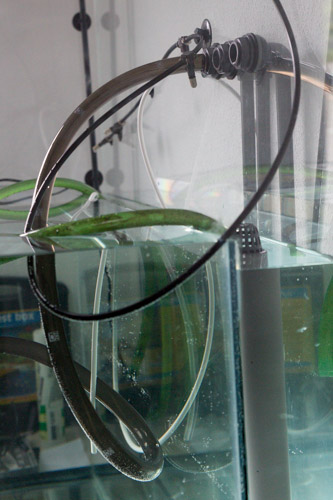Today I filled the paludarium fully. Now the water levels are exactly as projected, and overflow neatly into the sewer if there is any surplus.
Filled up
Fully filled, the paludarium weighs around 370 kilos right now. And I still need the Canopy on there, sand inside… But the cabinet is holding up perfectly. Nothing bending through, nothing giving way.
If the tap water or the reverse osmosis unit is turned on, it fills the aquatic part. The aquatic part overflows in the dirty-water part in the rear. If that overflows, it is dumped straight into the sewer:

Detail of the sewer pipe in the paludarium. Any access water will flow straight into the sewer. Note how the water is exactly leveled to the edge of the drain.
The inside of the paludarium is a bit of a construction site right now. It looks like this:

Water in the paludarium fully filled. The aquatic part left is about to overflow to the dirty-water part (right) and in turn that water is drained to the sewer.
Hoses ‘n stuff
There are a lot of hoses inside the paludarium right now. This is a picture I took that shows most hoses:

A bunch of hoses hanging inside the paludarium right now. A lot of hoses, and I haven’t even put in any cables yet!
If you look closely, you’ll see the thick greyish hose. This hose is connected to one of the feed throughs right now, either for the filtered water or tap water. The green hose is a temporary hose that I use to pump water from one part to the other just for testing. The thin white tube is the osmosis water entering the paludarium. The thin black tube is for the rain installation. The grey PVC pipe in the background is used to pump water up and through a lot of holes in the pipe, send the water down along the background.
The center feed through is unused at the moment. Future expansion 🙂 If ever I decide to use brackish water in the paludarium, I can no longer overflow the aquatic part into the rear section (the land plants would die!), so I’d need to convert the current filter output as a sewer drain and use this extra feed through as a line going back to the external filter. Don’t quite get it? No problem. I haven’t thought this one through anyway. It is good to have a spare feed through anyway 🙂




 RSS
RSS LinkedIn
LinkedIn Twitter
Twitter Email
Email
[…] to the “C”. Today I still program in both “C” and Python for fun (Arduino and Raspberry Pi […]